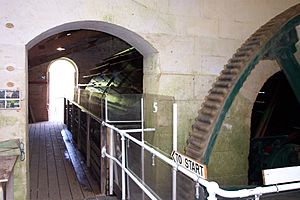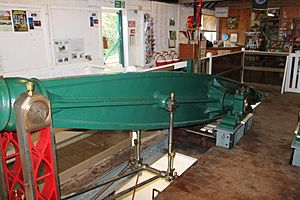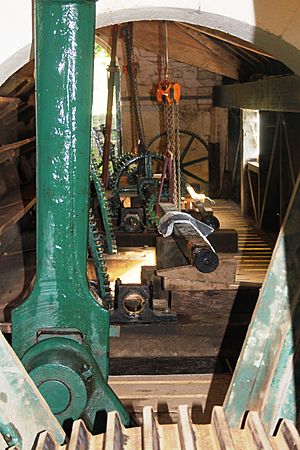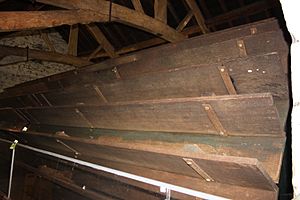Claverton Pumping Station facts for kids
Quick facts for kids Claverton Pumping Station |
|
|---|---|
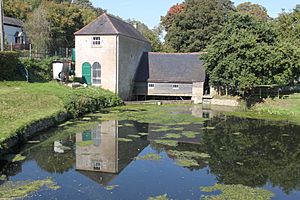
Claverton Pumping Station with the pump house on the left, the wheelhouse to the right and the millpond in the foreground
|
|
| Type | Pumping station |
| Location | Claverton, Somerset, England |
| Built | 1813 |
| Architect | John Rennie |
| Governing body | Claverton Pumping Station Group |
| Owner | Canal and River Trust |
|
Listed Building – Grade I
|
|
| Official name: Claverton Pumping Station | |
| Designated | 3 April 2019 |
| Reference no. | 1214608 |
|
Listed Building – Grade II
|
|
| Official name: Claverton Pumping Station | |
| Designated | 14 August 1984 |
| Reference no. | 399483 |
| Lua error in Module:Location_map at line 420: attempt to index field 'wikibase' (a nil value). | |
The Claverton Pumping Station is a special building in the village of Claverton, England. It helps move water from the River Avon up to the Kennet and Avon Canal. This amazing machine uses the river's own flow to power a giant water wheel. It's like a big, old-fashioned water elevator for the canal!
This pumping station is a very important historical site. It's known as a Grade I listed building, which means it's protected because of its special history and design. It got this higher protection in 2019.
A famous engineer named John Rennie built the station between 1809 and 1813. Its main job was to solve water problems on the canal. It has a huge wooden water wheel, about 24 feet wide. This wheel turns two large metal beams, which then power pumps. These pumps lift water about 48 feet high into the canal.
The station worked for many years, but it stopped in 1952. It became too expensive to keep it running. However, in the 1960s and 1970s, students from the University of Bath and volunteers worked hard to fix it. They brought the pumping station back to life by 1978. Today, the Canal and River Trust owns it, and volunteers keep it running. You can even visit it as a museum to see how it works!
Contents
How the Pumping Station Works
The Kennet and Avon Canal sits about 48 feet above the River Avon at Claverton. The pumping station is right next to the river. It's made from Bath Stone, a local type of rock. John Rennie designed this clever building.
Water for the station comes from the river, diverted by a small dam called Warleigh Weir. This water flows down a special channel, or leat, about 30 feet wide. It then goes over special gates called sluices, which can be opened or closed by hand.
The Giant Water Wheel
The water then powers a huge breastshot water wheel. This wheel is 24 feet wide and 17 feet tall! It's actually made of two sections, each 12 feet wide, with a small gap in between. The wheel has 48 wooden parts on each of its six metal rims. These parts hold 96 wooden boards that catch the water.
When the water hits these boards, it makes the wheel turn. The wood used for the wheel's parts is called Iroko. It's a strong wood that lasts a long time, even when it's wet and dry often.
Powering the Pumps
When the water wheel is working at full power, it uses about 2 tons of water every second. It spins about five times a minute. The wheel is connected to a large gear, called a pit wheel, which is over 16 feet wide. This pit wheel has 408 wooden teeth that fit into a smaller metal gear. This makes the smaller gear spin faster, about 16 times a minute.
From there, cranks move two long, metal rocking beams. These beams are 18 feet long and were made by a company called Boulton and Watt. Each beam drives a large pump, which also gets water from the leat. With every pump stroke, about 50 imperial gallons (230 litres) of water are lifted. This water travels through a 150-foot-long pipe up to the canal. The station can lift a lot of water, showing how powerful this old technology was!
History of the Pumping Station
Building the Canal
People first thought about building a waterway across southern England a very long time ago, between 1558 and 1603. They wanted to connect the Avon and Thames rivers. But plans didn't really start until the early 1700s. The Kennet Navigation opened in 1723, and the Avon navigation opened in 1727.
Later, in 1788, people suggested building the "Western Canal" to help trade. In 1793, John Rennie surveyed the route and made some changes. The canal was then called the Kennet and Avon Canal. Construction began after the Kennet and Avon Canal Act was passed on April 17, 1794.
Why a Pumping Station Was Needed
The new canal route had many locks. Locks help boats move up and down hills, but they also use a lot of water. Each time a boat goes through a lock, water is lost from the higher parts of the canal. This meant the canal needed a way to get water back.
Canals usually get water from rivers and streams. But if there isn't enough water, a pumping station like Claverton is needed. Another pumping station, Crofton Pumping Station, was built to the east. It opened in 1810 and used steam power, unlike Claverton's water wheel.
Building Claverton Pumping Station took a while. There were talks about water rights with other mills on the river. The water wheel was installed in March 1810, but the station didn't fully open until early 1813. Until then, boats couldn't use some locks when river levels were low.
Working Life and Closure
The pumping station worked constantly, supplying water for the busy canal. Over time, the large water wheel started to sag in the middle. In the 1840s and 1850s, changes were made to strengthen it, including adding a central support that split the wheel into two sections.
However, the opening of the Great Western Railway in 1841 meant fewer boats used the canal. The canal's business declined, and it eventually lost money. Other canals that fed into the Kennet and Avon also closed. By the early 1900s, the pumping station needed regular repairs.
In 1926, the railway company tried to close the canal, but people fought to keep it open. After World War II, the canal's control changed hands. By the 1950s, parts of the canal were closed due to poor upkeep. Claverton Pumping Station stopped working in 1952 when some of its wooden gears broke. An electric pump was installed to keep the water level up instead.
Bringing it Back to Life
After it closed, the pumping station was left empty for many years. But in the late 1960s, the Kennet and Avon Canal Trust suggested fixing it. Students from the University of Bath started working on it in 1969. They fixed rotten wood, added lights, and repaired the sluices and water wheel.
More volunteers joined in, and by 1972, a lot of progress had been made. They cleaned out the pond, replaced parts, and restored the water wheel. All 408 wooden teeth on the pit wheel were replaced, and the pumps were fixed. By February 1976, all the machines were working again! The pumping station officially reopened in 1978.
In 1981, new electric pumps were installed to help move even more water. From 2012 to 2016, the pumping station had another big restoration. All the wooden parts of the water wheel and the pit wheel teeth were replaced.
Claverton Pumping Station has won awards for its historical importance and restoration work. It received a National Transport Trust Red Wheel and an Engineering Heritage Award.
Visiting Today
Today, volunteers keep the Claverton Pumping Station running. It's open to the public regularly, except for winter maintenance. Sometimes you can see the wheel turning and pumping water, and sometimes it's static. Pumping days are announced in advance, but they depend on the river conditions and the old machinery. There's also a small working model of the station inside the pump house that you can see.


